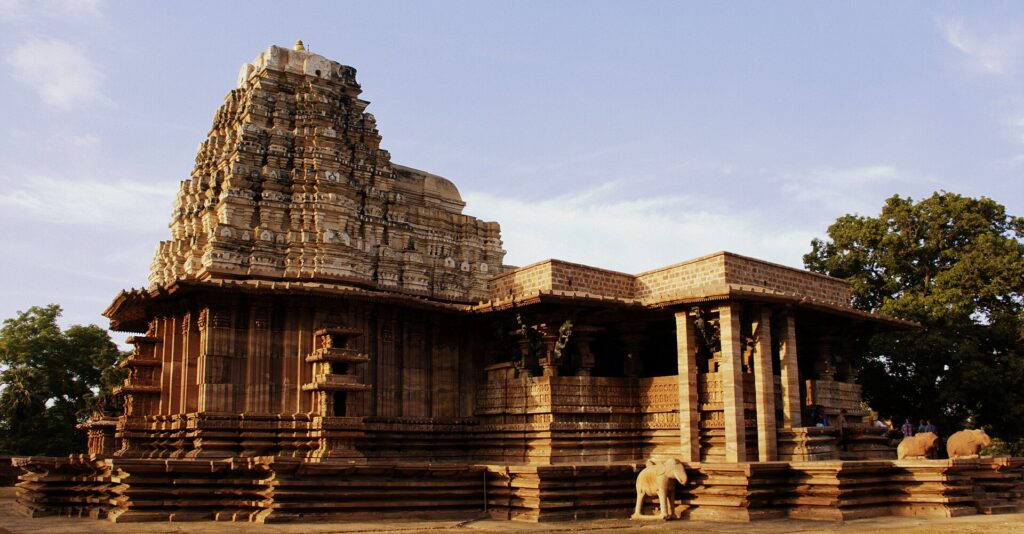
Image Source: SukuPhotography
Telangana, located in southern India, was officially formed on June 2, 2014, as the 29th state of India after its separation from Andhra Pradesh. The state is landlocked, bordered by Maharashtra in the north and northwest, Chhattisgarh in the northeast, Karnataka in the west, and Andhra Pradesh in the south and east. Hyderabad serves as the capital and the cultural heart of Telangana, renowned for its architectural marvels, tech-driven economy, and rich cuisine.
Spanning an area of around 112,077 sq km, Telangana sits atop the Deccan Plateau , giving it a unique topography marked by rocky hills, fertile river valleys, and dry deciduous forests. Major rivers such as the Godavari, Krishna, Manjeera , and Musi nourish the land, making it agriculturally productive.
Table of Contents
ToggleGeography of Telangana
Telangana’s geography is diverse—from arid plateaus to green valleys. The Godavari Basin dominates the northern part, while the Krishna River Basin shapes the southern terrain. Forests cover nearly 25% of the state, home to wildlife sanctuaries like Eturunagaram, Kawal, and Kinnerasani.
The climate is primarily tropical semi-arid , with hot summers (March–June), moderate monsoons (June–September), and pleasant winters (November–February). The Eastern Ghats run along parts of Khammam and Warangal, while granite rock formations, particularly around Hyderabad, give the city its distinct geological beauty.
Key geographic highlights:
Highest point: Doli Gutta (965 m) in Jayashankar Bhupalpally district
Major rivers: Godavari, Krishna, Musi, Manjeera, Penganga
Famous waterfalls: Kuntala, Pochera, Bogatha, Ethipothala
History of Telangana
Telangana’s history stretches back over 2,000 years , marked by a succession of dynasties and empires. The region was once part of the Satavahana Empire (230 BCE–220 CE) , known for trade and Buddhist learning centers. Later, it came under the rule of the Kakatiyas (12th–14th century) , who made Warangal their capital and constructed architectural wonders like the Thousand Pillar Temple and Ramappa Temple (a UNESCO World Heritage Site).
After the fall of the Kakatiyas, Telangana came under the Delhi Sultanate, followed by the Bahmani Sultanate and later the Qutb Shahi dynasty , which founded Hyderabad in 1591. The Nizams of Hyderabad then ruled for nearly 200 years, making Hyderabad one of India’s richest princely states. Their legacy endures through palaces, gardens, cuisine, and the famed Hyderabadi pearls .
In 1948, after India’s independence, the princely state of Hyderabad was integrated into the Indian Union. Telangana later became part of Andhra Pradesh but achieved separate statehood in 2014 , fulfilling a decades-long demand for political and cultural recognition.
Top Places to Visit in Telangana
Hyderabad—The City of Pearls
Charminar: The city’s heart, built in 1591 by Sultan Muhammad Quli Qutb Shah.
Golconda Fort: Once the diamond trading hub where the famous Kohinoor diamond was discovered.
Hussain Sagar Lake: An engineering marvel linking Hyderabad and Secunderabad.
Chowmahalla Palace: Former seat of the Asaf Jahi dynasty with stunning Mughal and Persian architecture.
Ramoji Film City: The world’s largest film studio complex, perfect for family entertainment.
Laad Bazaar: Famous for Hyderabadi bangles, pearls, and traditional Attar perfumes.
Warangal – The Kakatiya Capital
Warangal Fort: Known for its Kakatiya Toranas (stone gateways) and intricate carvings.
Ramappa Temple: A 13th-century marvel built from floating bricks.
Bhadrakali Temple: A spiritual landmark overlooking the lake.
Laknavaram Lake: A scenic lake surrounded by lush forests, ideal for boating and picnics.
Khammam & Bhadrachalam – The Spiritual Belt
Khammam Fort: Built by Kakatiya rulers, later expanded by the Musunuri Nayaks.
Bhadrachalam Temple: Dedicated to Lord Rama, a major pilgrimage site on the Godavari River.
Kinnerasani Wildlife Sanctuary: A serene retreat with forests and river valleys.
Adilabad—Nature’s Paradise
Kuntala Waterfalls: The highest in Telangana, located amidst dense forest.
Pochera Falls: A multi-tiered natural wonder.
Basar Saraswati Temple: Dedicated to the Goddess of Learning; families bring children here for their first writing ritual (Aksharabhyasam).
Karimnagar and Nizamabad—Heritage and Serenity
Elgandal Fort: Overlooking the Manair River, with unique defense structures.
Lower Manair Dam: A beautiful reservoir popular for evening strolls.
Pocharam Wildlife Sanctuary: Ideal for nature lovers and birdwatchers.
Alisagar Reservoir: Surrounded by landscaped gardens and boating options.
Culture and Festivals of Telangana
Telangana’s culture reflects a rich blend of Deccan, Telugu, and Persian influences . The people are warm, artistic, and deeply spiritual.
Bathukamma: A floral festival celebrated by women, symbolizing nature and sisterhood.
Bonalu: A major festival honoring Goddess Mahakali with colorful processions.
Peerla Panduga: A celebration of religious harmony among Hindus and Muslims.
Sammakka Saralamma Jatara: Asia’s largest tribal festival held in Medaram every two years.
Perini Sivatandavam: A classical warrior dance that dates back to the Kakatiya period.
Popular Dishes of Telangana
Telangana cuisine is earthy, spicy, and full of character. Influenced by Deccan flavors and Mughal kitchens, it offers a blend of vegetarian and non-vegetarian delicacies.
Hyderabadi Biryani – The state’s culinary crown jewel made with saffron rice, marinated meat, and aromatic spices.
Kodi Pulusu—Traditional chicken curry cooked with tamarind and regional spices.
Sajja Rotte & Jonna Rotte – Millet-based flatbreads reflecting the agrarian culture.
Pachi Pulusu—A tangy tamarind soup often served during summers.
Bagara Baingan – Eggplant curry with groundnut and sesame seed gravy.
Qubani Ka Meetha—A dessert made from stewed apricots, served with cream or ice cream.
Double Ka Meetha—A royal bread pudding flavored with saffron and dry fruits.
Top Things to Do in Telangana
A land that offers a mix of heritage, adventure, spirituality, and gastronomy:
Walk through Old Hyderabad’s bazaars and taste Irani Chai with Osmania biscuits.
Visit Golconda Fort for the light and sound show narrating its royal history.
Explore Kakatiya heritage trails in Warangal and Hanamkonda.
Go on a spice plantation tour in Khammam and tribal circuits in Adilabad.
Take a boat ride at Laknavaram Lake or Durgam Cheruvu .
Visit Ramoji Film City for film studio tours and entertainment.
Attend the Hyderabad Literature Festival or Deccan Festival for cultural immersion.
Souvenirs to Buy from Telangana
Pochampally Ikat Sarees: Handwoven with geometric patterns, a GI-tagged craft.
Bidriware: Silver-inlay metal art from Hyderabad, perfect for décor.
Nirmal Paintings: Traditional art from Nirmal district featuring mythological scenes.
Lac Bangles: Found near Charminar, handcrafted with intricate designs.
Hyderabadi Pearls: World-famous for their natural shine and elegance.
Best Time to Visit Telangana
Winter (October –February):Ideal for sightseeing and exploring heritage sites.
Monsoon (June –September):Perfect for nature trips, waterfalls, and greenery.
Summer (March –May):Hot, but suitable for cultural tours and temple visits.
How to Reach Telangana
By Air: Rajiv Gandhi International Airport (Hyderabad) connects Telangana to all major Indian and international cities.
By Rail: Major railway stations – Secunderabad, Warangal, Nizamabad, and Khammam—connect to Mumbai, Delhi, Bengaluru, and Chennai.
By Road: Excellent connectivity via NH44, NH65, and state highways. Luxury buses and rental cabs operate across the state.
Conclusion
Telangana is a living museum of the Deccan’s past and present—where Kakatiya stone temples, Nizam-era palaces, and modern IT towers coexist harmoniously. The fragrance of biryani in Hyderabad, the chants of Bonalu festivals, and the beauty of Godavari’s banks create an experience that is both royal and rooted. Whether you’re a heritage seeker, a food enthusiast, or a modern traveller, Telangana promises a journey rich in stories, flavors, and warmth.
